Politics
Feds Consider Removing MDMA From Workplace Drug Testing While Adding Fentanyl Instead
Proposed changes to federal workforce drug testing guidelines that are currently being reviewed by officials would remove screening for MDMA—which has only rarely appeared in workers’ urine samples during recent years—and add testing for fentanyl, a substance that’s become far more widespread in unregulated drug markets over the past decade.
Both MDMA—which the federal government could reschedule later this year—and the related substance MDA, which the government would also remove from inclusion in required drug tests under the proposed changes, were less common in tests than PCP, which was also considered for removal from the testing panel but for now will remain.
The offered changes were the topic of a meeting last month of the Substance Abuse and Mental Health Services Administration’s (SAMHSA) Drug Testing Advisory Board (DTAB), which advises the agency’s drug testing and laboratory testing certification activities.
While MDMA is slated for removal, fentanyl is “involved in a large proportion of overdose deaths in the United States and is therefore an important public safety concern,” SAMHSA said in a Federal Register posting about the meeting. It’s also increasingly used as a standalone substance, the agency said. Previously the substance was more common in conjunction with other opioids or unintentionally as an adulterant in other unregulated drugs.
The proposed threshold for a fentanyl positive under the Federal Workforce Drug Testing Programs would be 1 nanogram per milliliter of blood.
Fentanyl was the third most frequently identified drug of all substances reported by forensic laboratories, according a 2022 National Forensic Laboratory Information System report cited by SAMHSA, accounting for 13.81 percent of all drug positives.
As for the two psychedelics, SAMHSA’s Federal Register posting says they’re set for removal “because the number of positive specimens reported by [Health and Human Services (HHS)]-certified laboratories does not support testing all specimens for MDA and MDMA.”
According to National Laboratory Certification Program (NLCP) data from 2021 and 2022, the posting says, “the positivity rate for MDMA ranges from 0.001 to 0.003%, and a review of the results indicate that >25% of the positive specimens are likely agency blind samples. MDA has a lower positivity rate than MDMA and both have lower positivity rates than phencyclidine (PCP).”
“SAMHSA also considered removing PCP,” it adds, “but decided against this change.”

SAMHSA
“While PCP has an overall positivity rate nearly as low as MDMA, there are regional differences in positivity, with some areas of the country having much higher rates,” the agency explained, “so PCP remains a regulated test analyte.”
Case-by-case testing, for example in post-accident drug testing or instances where there’s reasonable suspicion of use of MDMA or MDA, would still be permitted under the changes.
Financially, the removal of MDMA and MDA is expected to save between $3,800 and $38,000 per year, according to an NLCP cost/benefit analysis of the changes, though it notes that additional administrative costs “will likely be incurred” as a result of the change.
Adding fentanyl, meanwhile, would add a projected $9,139 to $192,850 in annual costs. The greater costs compared to the savings from MDMA/MDA removal is the result of higher initial testing costs of $0.23 to $5 per specimen to test for fentanyl compared to $0.10 to $1.00 per specimen to test for the psychedelics.
Confirmation testing for both substances is the same, though the process for fentanyl is expected to add $304 to $2,850 in annual costs, while positivity rates in initial tests for MDMA and MDA are so low that savings on confirmation testing costs would be “negligible,” the NLCP report says.

RTI International / NLCP via SAMHSA
Positivity rates have remained low for MDMA for more than a decade, according to a SAMHSA report on the proposed changes that looked at data stretching back to January 2013.
The highest positivity rate of all 10 years analyzed was 0.005%, with the last three consecutive years of data (2021–2023) showing rates of roughly 0.002%.
According to a SAMHSA slideshow from the meeting last month, the next step on the proposal is for the board to present its responses to public comments received during a period that closed in January. Still ahead is a federal review process that could include multiple comment rounds and revisions, followed by a formal explanation and announcement of the changes.
DTAB previously discussed the changes at a meeting in December.

SAMHSA
Betty Aldworth, director of communications and post-prohibition strategy for the Multidisciplinary Association for Psychedelic Studies (MAPS), described the SAMHSA proposal as “a bureaucratic change driven by the preponderance of fentanyl in the unregulated drug market and MDMA use patterns—perhaps most notably that it is used rarely and doesn’t have characteristics suited for the workplace.”
But she also said the decision will have “at best, a neutral impact on the overdose crisis.”
“It’s the same failed drug war ‘prevention’ tactics that don’t prevent chaotic drug use and further stigmatize people with opioid use disorder, a serious mental health condition,” she told Marijuana Moment in an email. “Public safety would be better served—more lives would be saved—if the dollars were spent on workplace testing for fentanyl were immediately diverted to evidence-based treatment and overdose prevention activities.”
Aldworth added that she’s also concerned for those workers who use fentanyl with a doctor’s prescription, “as they may be forced to make a choice between their medical privacy or the ability to keep and get a job.”
“If we wanted to make workplaces and roadways safer, we would immediately divest from expensive workplace drug testing and divert those resources to cognitive impairment testing, which could be installed on smart phones or even in vehicles and made a routine part of the workday,” she said. “Impairment can be caused by illegal drugs, prescription drugs, OTC drugs, fatigue, stress, grief, or even dehydration or hunger. Cognitive impairment testing is inexpensive, ubiquitously available, and a far better measure of a person’s performance at any given moment.”
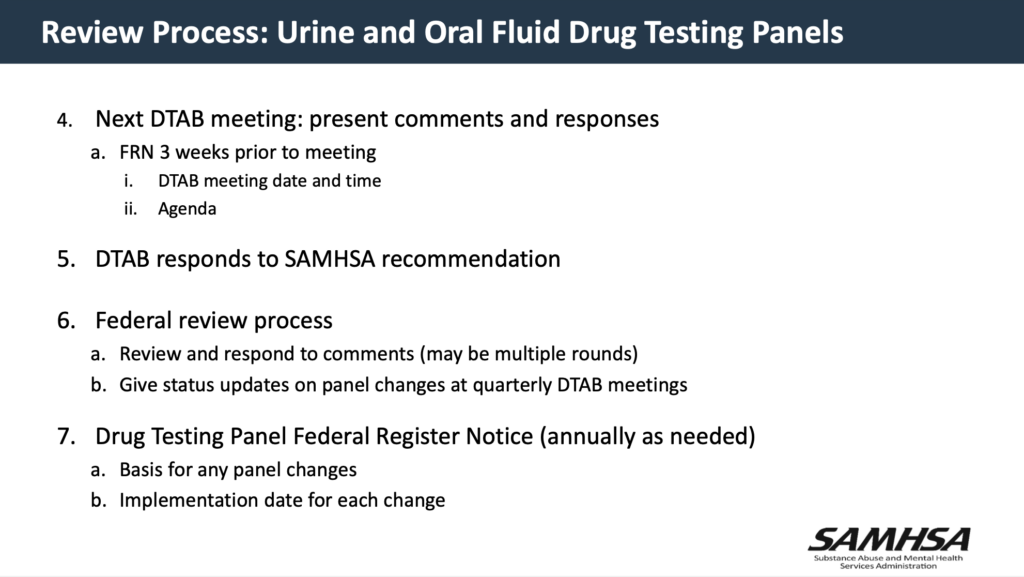
SAMHSA
The proposed adjustments in the federal guidelines come as shifts in drug laws and use patterns force both public and private organizations to rethink drug testing programs.
Regarding marijuana, however, which has generally been the focus of most legislative discussions on illicit substances and driving, a Justice Department researcher said in February that states may need to “get away from that idea” that marijuana impairment can be tested based on the concentration of THC in a person’s system.
Last month, meanwhile, a federal traffic safety agency said there’s “relatively little research” backing the idea that THC concentrations in blood can be used to determine impairment, calling into question laws in several states that set “per se” limits for cannabinoid metabolites.
Separately, Job Corps, the national job-training program administered by the U.S. Department of Labor, announced changes to its drug-screening protocol for marijuana earlier this year in order to avoid punishing young people for using cannabis prior to starting the program.
And earlier this month, new data showed that the number of positive drug tests among commercial drivers fell last year compared to the year before, dropping from 57,597 in 2022 to 54,464 in 2023. At the same time, however, the number of drivers who refused to be screened at all also increased by 39 percent.
Photo courtesy of Pretty Drugthings on Unsplash



